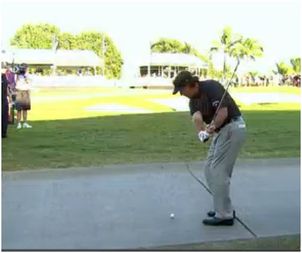 PGA Tour star Phil Mickelson's shot from a cart path at the 17th hole during the second round of the World Golf Championship - Cadillac Championship at the Doral Golf Resort and Spa had spectators and even Steve Sands the interviewer from the Golf Channel in awe. But listening to Phil during the post round interview he was matter of fact about the shot. Why was this so? The reason is that he has practiced this type of shot before (many times) and knows what to expect, and could factor in the variables for the 47 yard pitch shot. A player like Phil at some point during practice sessions has put himself in situations that most golfers would probably only find them in once a year and learn't how to play that shot. In the interview he explained that he had to carry the ball 30 yards in the air to the putting surface and he knew that the club head would bounce off the cart path with an ascending strike and launching the ball higher. This creates an extra five yards of carry and roll out to the 47 yard hole position. It was the same on the 5th hole when he missed the fairway and he knew that from the rough the ball would not have any backspin so he factored the extra roll and went on to make a birdie which kicked started his round, resulting in a 67 at the end of the day.  As Phil explained "when you're on a cart path you don't need to open the club face as that adds "bounce" which raises the leading (bottom) edge of the club face which will hit the ball above the equator resulting in a "thin" shot and the ball flying further than you want over the green." He advised a square club face as shown in the picture on the left which keeps the "bounce" below the equator of the ball. Secondly you need to understand that the club (which normally on turf with a wedge would be descending) in this circumstance the cart path is going to make the club head bounce and hit the ball with an ascending strike. So just like Phil we at Pro Tour Golf College regularly make our students practice hitting shots from unlikely positions we refer to as "trouble shots" and learn the different techniques required, and also anticipate the type of trajectories and spin variables that each situation brings. And just like Phil it doesn't seem like an amazing shot because you already know the outcome before you execute the shot.  An interesting observation after Phil made the shot is there is a mark on the cart path just behind where the ball was, and another mark in front of where the ball lay! Now Phil said that after striking the cart path the club-head is ascending so how did that second mark come about? Well I have to get help from Isaac Newton and his Laws of Motion and in particular his 3rd Law of Motion which states "For every action there is always an equal and opposite reaction." Therefore that second mark came about when the club head struck the ball applying force to it and the ball in turn applied that force back to the club-head causing it to descend down to the cart path for a second time. Mystery solved! Now the next time you practice your green-side scrambling skills make sure you also practice the "trouble shots" from the difficult lies around the green, so that if you ever get faced with a situation similar to Phil's, you can be confident that you've practiced it so that it is likely it will pay off for you. Not to mention that it's fun to practice the strange and unusual shots. David Milne and Lawrie Montague - Pro Tour Golf College Your Success On Tour is Our Business  Open up any golf magazine or browse through most online golf websites and you will be exposed to golf fitness articles proclaiming the virtues of golf fitness. With this come the ‘must-do golf exercises’ that will gain you greater distance off the tee, more accuracy, etc. But are these exercises right for you? Just as a teaching golf professional should analyse many aspects before providing you with tuition on your swing and game, ‘golf fitness exercises’ should only be prescribed after a player is properly assessed, preferably via a golf specific screening by a trained physiotherapist who specializes in this. A golf specific physical screening assesses your body to find aspects that will limit your ability.  These restrictions may physically limit you technically, i.e. to develop the desired swing with your coach. The restrictions may also increase your risk of injury, especially considering the repetitive nature of the game of golf and the training required. Once you have Golf specific screening performed, the information will then be available to develop an exercise program that will accurately address your areas at fault. Of course as with any program your needs will change over time and a re-assessment will be needed to make adjustments to your program. Who Needs a Golf Specific Physical Screening? Of course I would like to answer any golfer! In reality, the players who will benefit most from an assessment, be they club golfer, elite amateur or touring professional, are those who are looking to improve their game and are prepared to work at it. As we all know it takes hard work and dedication to improve your golf game. Martin McInnes - GolfFit Physiotherapy  The athlete who craves an outcome experiences a torrent of emotions as a direct result of this craving. The emotions that he experiences negatively affect his performance. In response, he seeks advice as to how to deal with the emotional storm that is within him. He then seeks advice from a coach or a consultant who prescribes a series of routines and rituals in an attempt to limit the effect of the emotions on his performance. He may even be told to downplay the emotions or to disregard them. He may be told to breathe in a certain way and to keep an even countenance. He practices these rituals, which almost becomes a sport in itself. When the rituals work, he is satisfied. When they don’t, he experiences the same emotions which are now directed toward the failure of the rituals.  He then seeks a new set of rituals. And the process begins anew. Prescriptions, routines, and rituals have made the modern athlete a robot. While they may help to a degree, they will never unleash his ultimate performance. Human beings are addicted to solutions. Rare is the human being who explores the problem. The athlete seeks a prescription the way a sick man seeks a tonic. A desperate attempt at escape. If you continue to run from your emotions, how far do you think you will get? Can one really escape himself? It is because you keep wrapping yourself in bandages that you have become so stiff. If you never explore the nature and source of your emotions, you will always be a slave to them. Kapil Gupta, M.D. [email protected] www.siddhaperformance.com  Each year on the men’s and women’s golf tours in all parts of the world the competitive scoring average is lowering as more ambitious and highly skilled golfers join the tour in their quest to become the next big thing in golf. Like many, we closely follow the professional men’s and women’s golf tours both at local level as well as all the major international ones. At local level we know many of the professional golfers playing the tournament circuit and we get excited when they are in contention in tournaments and we sympathize with them when they’re not playing their best.  Playing professional golf tournaments is a lot like riding a roller-coaster. You have the high scores and you have the low scores. Playing amateur or professional golf tournaments competitively requires an ability to ride these normal highs and lows and above all else, find a way to keep producing competitive golf scores. This is by far the most important skill to develop. Therefore every golf skill that you practice should in all likelihood lead you to a lower golf score average and push you towards becoming one of the best golfers on your golf tour. The challenge with this is that it’s not easy to accomplish because for many golfers practicing to improve is more of a lottery than a science. Golfers will try all sorts of approaches to improve their golf skills and sadly quite often they’re a long way from practicing so they improve. In our experience we have found that there are a number of practice habits that we believe hold advanced and elite golfers back from making progress. We call these the 7 Deadly Golf Practice Sins and these habits will hold you back from playing the best golf of your life. See if you have any of the following deadly practice sins in your game. 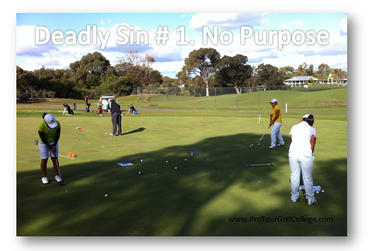 Hitting Golf Balls Without a Clearly Defined Purpose The easiest thing to do is perform a task without thinking too much about it. When skills get to an automatic level (like driving a car) very little conscious thought is involved in the process. This is a good thing for the many tasks we perform every day, but when it comes to practicing golf shots this is the last thing you want to do. It is surprising how many advanced golfers hit balls without thinking a lot about their major definite purpose. Your major definite purpose is your ultimate reason for applying effort every time you practice golf. It defines the reason WHY you are there and is connected to your longer term goals. When you practice be very clear how the practice you’re performing will change some aspect of your performance in the future. Don’t just ‘hit balls,’ prepare, plan and perfect your golf skills practice to drive your scores down.  Working On Your Golf Swing Technique Whilst Trying to Perfect Shots to a Target You hear a lot of talk about the research on multi-tasking and here’s what it says. When human being try to focus on performing two or more tasks at the same time they fail! Your conscious mind is incredibly clever at helping you to perform one skill expertly or manage one challenge at a time, but when you ramp it up to two or more tasks you will fail. Hitting golf shots whilst you try to perfect your golf swing technique is one of the most common multi-tasking errors performed by golfers. It might seem logical to hit shots to a target and at the same time make sure that your X equals your Y but you’re just asking for trouble. Separate the two; if you’re working on your technique take the target out of the equation. If you’re working on your targeting take the technique thinking out of the equation. You might think that performing both these tasks at the same time is saving you time, it doesn’t it actually increases the overall time it take to learn and habituate the skill. 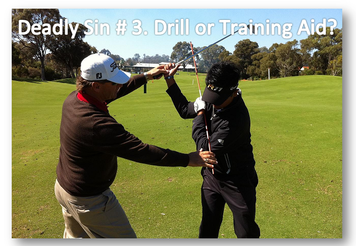 Practicing a Drill or Using a Training Aid Because Someone Else is What is the purpose of a practice drill? The purpose of a practice drill is to reinforce a correct feel sensation repeatedly until you turn it into a habit. The drill type should be relevant to your particular needs-not someone else’s. What is the purpose of a training aid? The purpose of a training aid like a practice drill is to reinforce a particular feel to habituate it. Many advanced and elite golfers copy the drill routines and use training aids of another golfer (like a successful tour professional) which makes no sense as every golf swing is as different as every fingerprint is – no two are the same. You need your golf instructor to design a highly specific practice drill with or without a training aid for you to reinforce an ideal behavior rather than copying the drill of the month straight out of the latest golf magazine.  Overdosing on Video Analysis Video as a tool to help a golfer to understand a particular swing flaw or in-fact a swing goal is a very useful tool. But that is just it; it is a tool - not a crutch. With video cameras now in every mobile phone and apps that allow the golfer to dissect the swing into parts, we are seeing a new emerging problem in young golfers who are becoming addicted (can’t stop) to perfection of their golf swing technique via a video. Golfers are spending more time looking at their swing than actually working on it and developing the necessary feels required to compete with. Video should be used carefully and ideally with professional assistance to interpret results correctly. Video helps you to understand your goals but practice turns it into a reliable feel. You should spend more time developing the correct feel and less time analyzing your swing positions.  Spending Too Much Time Texting or on Facebook and Twitter Rather Than Practicing Your Golf Skills Do yourself a favor and turn your mobile phone off when you go to practice. This is particularly true of golfers aged between 15 and 25 who spend a great deal of time checking Facebook and twitter instead of putting in the hours of practice required to become a champion golfer. We have witnessed this occurrence continually on the practice ground where golfers get lost in cyber-world and lose track of time. Over the past few years and it seems to be getting worse. Mobile phones are a huge distraction and will significantly influence your practice flow and work output and ultimately for many, they will stop you from becoming the golfer you’re trying to become. It might seem like a trivial thing, but it isn't. Practicing requires a commitment to focus and you develop this through consistent effort and intent without distraction.  Listening to Music Whilst You Try to Practice Your Golf Skills This deadly sin has been around for a long time and seems harmless enough until you understand what is actually going on. Listening to songs on your iPod whilst you practicing to perfect golf skills again doesn't make a lot of sense. This deadly sin is one of the biggest ones and there’s no doubt that many reading this won’t agree with us but we need to share the message to those who are really serious about improving their game. The constant theme with our deadly practice sins is distraction and distraction erodes ability and many of the compact instruments that do this were never designed for elite performers. They were designed for the general public. Your brain is an incredibly marvelous system that above all else has as its number one goal to prioritize information it receives through your senses (ears, nose eyes…). When you practice golf skills and you’re concentrating on executing golf shots with precision whilst at the same time listening to music from your iPod vibrating on your ear drums makes it extremely challenging for your brain to prioritize the information it receives. You need to decide what your priority is; do you want to listen to music? Or do you want to execute golf strokes with precision, because you cannot do both really well.  Practicing Skills You’re Good At and Ignoring Ones You’re Not Good At This is an old chestnut but a good one, practicing skills that you’re already good at. At Pro Tour Golf College we spend a lot of time observing golfers practicing. Not just the students in our tour bridging program but those that practice at our facility, and when you spend enough time doing this the one constant is that a lot of advanced golfers perform the same routines over and over with the same clubs to the same holes. It’s what we call ‘mindless practice’ where you perform your routines and go home satisfied in the knowledge that you have accomplished the goal of practicing things that you are good at. What you want to do is ‘mindful practice’ where you pre-plan your practice and decide on the weakest-most-important skills that will enhance your performances on the golf course. Then you design your practice routines to work on the weaker skills that aren't fun to practice (because you are not good at them) but that will help you to play a lot better. So there you have it. Our 7 Deadly Practice Sins that we have found will severely affect your future success if your desire is to become a top ranked amateur or professional golfer. You might not agree with our list of sins, but it is hard to argue that practicing these habits will be beneficial to your ongoing development as a golfer. We hope you enjoyed the article and if you have any suggestions on habits that you believe also affect golfers performances that we haven't mention please let us know. Lawrie Montague and David Milne - Pro Tour Golf College Your Success On Tour is Our Business  The PGA Tour's top 10 players have an area of their game that is holding them back and stopping them from getting to the next level. From world number one Rory McIlroy to Bubba Watson ranked 11th in the World Golf Rankings, they all can get better and they all know precisely which area is holding them back. As Pro Tour Golf College co-director Lawrie Montague has documented in his last two articles, the world's top ten players are already great players. Because the PGA Tour's Shot-link statistics has such accurate information for all areas from the shortest putting stats to the longest drives, these players can still find room to drive their scores down further. And they do so because they work harder in the area's that will make the most difference! Lets start with Bubba Watson; we all know he bombs it miles, can maneuver the ball both ways, and was ranked 2nd in hitting greens in regulation in 2012. So where is his weakness? It's his flat stick (Putter) ranking 158th in the strokes gained-putting statistic. He was never better ranked than 120th in 3 to 5 feet, 5 to 15 feet and 15 to 25 feet. So is there a reason why putting is his Achillies Heel? Some will argue that he hits more greens than most so will have more putts, as his proximity to hole is further than those who miss greens and chip it close. This doesn't hold credence anymore as stroke gained-putting eliminates that and only calculates his putting against the rest of the field. I don't have any proof or scientific backing, but I believe just like Seve Ballesteros who also loved to maneuver the ball, hitting or stoking a straight shot - which essentially putting is, does not fit their eyes.They would prefer to hit a big breaking putt than be faced with a putt with very little break in it. Unless Bubba can work through the boredom of practicing straight putts he will not be a prolific winner on the PGA Tour and get into the top five of the World Golf Ranking.  Now we come to the ever popular Phil Mickelson and the talk of his new driver and improved accuracy which allowed him to win the Waste Management Phoenix Open last month. Last year he averaged 54.31% fairways (ranked 173rd) and this year he is averaging 51.62 so he's actually gone backwards. This translates to hitting 64.14% Greens In Regulation ranking him at 118th which makes it tough to win regularly like we are used to seeing Phil do in years gone by. At number five is Louis Oosthuizen and he is ranked number one in putting from 3 to 5 feet but his longer putting and short game skills if improved will move him closer toward that number one spot. Last year he ranked 95th in strokes gained-putting, 144th in bunker saves and 131st in scrambling. Like most good ball strikers like Lee Westwood, Adam Scott's short game skills tend to be his weakness. It was no more glaring than when Louis didn't get it up and down from the front edge of the 10th green at Augusta (1st playoff hole) which set the stage for Bubba to pull off that huge curving wedge from deep in the pine trees to steal the green jacket from Louis last year. 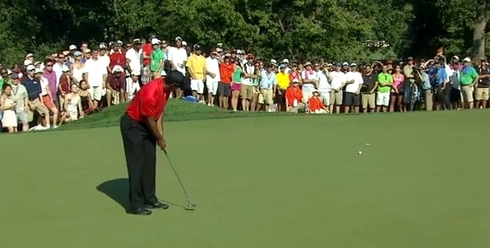 At number four and three Brandt Snedeker and Luke Donald lack that extra 10 meters off the tee, but keep maxing out their game from inside 100 meters and are consistently the best putters on tour We are now with the top two golfers in the World Golf Rankings Rory McIlroy and Tiger Woods. Tiger toward the end of last year started to improve his distance control with his wedges and his driver although still not good his misses were more in play. So where can he make improvements and dominate the game like he use to. It's pretty simple, last year he ranked 2nd in scoring with 68.4 but his Saturday and Sunday scoring was a full two shots higher. In 2009 when he won six times on tour his weekend scoring average was 68.4 and from 2000 to 2002 and 2005 to 2009 he was ranked one or two in final day scoring! Why didn't he win a Major in 2012? Because his final day scores were 74,75,73,72. and the solution for him is to get into the same "performance state" that he does on Thursday and Friday and we will see him regain the number one spot in the World Golf Rankings in the not too distant future.  Rory McIlroy the current world number one has had a couple of wonderful years and has dominated the Majors he has won, so what is the area that is holding him back? With the help of putting guru Dave Stockton he is now middle of the road ranked 80th in strokes gained-putting. But if you dig deeper and have the stats to back it up as we do at Pro Tour Golf College, Rory is actually being held back with his 3 to 5 feet putting 86.67% (ranked 102nd) and pitching from 50 to 75 yards (17' 10" proximity to hole and ranked 140th) and 75 to 100 yards (17' 7" proximity to hole and ranked 100th). When you consider the best in the above categories average 10 feet proximity to hole, he is not going to make more putts consistently from 17 feet compared to his opposition from 10 feet. Its as simple as that. No magic, just keep good effective statistics on your game and crunch the numbers, and even when you are at the very top you can always find parts of your game that if improved will drive your competitive scoring average down guaranteed. David Milne and Lawrie Montague - Pro Tour Golf College Your Success On Tour is Our Business |
Archives
June 2019
|
Proudly Supported By
Copyright © 2011 - 2018 Pro Tour Golf College
Website Managed By Golf Performance Media
All Rights Reserved
Website Managed By Golf Performance Media
All Rights Reserved

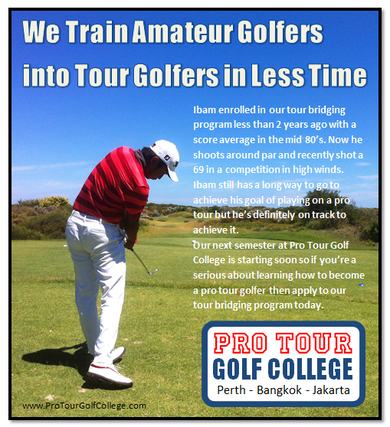


 RSS Feed
RSS Feed



